Potrebujeme váš súhlas na využitie jednotlivých dát, aby sa vám okrem iného mohli ukazovať informácie týkajúce sa vašich záujmov. Súhlas udelíte kliknutím na tlačidlo „OK“.
ASTM C423-09a
Standard Test Method for Sound Absorption and Sound Absorption Coefficients by the Reverberation Room Method (Includes all amendments And changes 2/6/2017).
Automaticky preložený názov:
Štandardná skúšobná metóda pre absorpciu zvuku a zvukovú pohltivosť koeficientov u dozvukovej miestnosti metódy
NORMA vydaná dňa 15.10.2009
Informácie o norme:
Označenie normy: ASTM C423-09a
Poznámka: NEPLATNÁ
Dátum vydania normy: 15.10.2009
Kód tovaru: NS-13351
Počet strán: 12
Približná hmotnosť: 36 g (0.08 libier)
Krajina: Americká technická norma
Kategória: Technické normy ASTM
Kategórie - podobné normy:
Anotácia textu normy ASTM C423-09a :
Keywords:
acoustical, acoustics, decay rate, noise, noise reduction coefficient, reverberation room, Acoustical tests, Decay rates, Noise reduction coefficient, Reverberation room method, Sound absorbing/insulating materials/applications, ICS Number Code 91.120.20 (Acoustics in buildings. Sound insulation)
Doplňujúce informácie
| Significance and Use | ||||
|
Measurement of the sound absorption of a room is part of the procedure for other acoustical measurements, such as determining the sound power level of a noise source or the sound transmission loss of a partition. It is also used in certain calculations such as predicting the sound pressure level in a room when the sound power level of a noise source in the room is known. The sound absorption coefficient of a surface is a property of the material composing the surface. It is ideally defined as the fraction of the randomly incident sound power absorbed by the surface, but in this test method it is operationally defined in 4.2. The relationship between the theoretically defined and the operationally measured coefficients is under continuing study. Diffraction effects usually cause the apparent area of a specimen to be greater than its geometrical area, thereby increasing the coefficients measured according to this test method. When the test specimen is highly absorptive, these values may exceed unity. The coefficients measured by this test method should be used with caution because not only are the areas encountered in practical usage usually larger than the test specimen, but also the sound field is rarely diffuse. In the laboratory, measurements must be made under reproducible conditions, but in practical usage the conditions that determine the effective absorption are often unpredictable. Regardless of the differences and the necessity for judgment, coefficients measured by this test method have been used successfully by architects and consultants in the acoustical design of architectural spaces. Field Measurements—When sound absorption measurements are made in a building in which the size and shape of the room are not under the operator's control, the approximation to a diffuse sound field is not likely to be very close. This matter should be considered when assessing the accuracy of measurements made under field conditions. (See Appendix X2 for a procedure that can be used in the field with less sophisticated instrumentation.) |
||||
| 1. Scope | ||||
|
1.1 This test method covers the measurement of sound absorption in a reverberation room by measuring decay rate. Procedures for measuring the absorption of a room, the absorption of an object, such as an office screen, and the sound absorption coefficients of a specimen of sound absorptive material, such as acoustical ceiling tile, are described. 1.2 Field Measurements—Although this test method primarily covers laboratory measurements, the test method described in 4.1 can be used for making field measurements of the absorption of rooms (see also 5.5). A non-standard method to measure the absorption of rooms in the field is described in Appendix X2. 1.3 This test method includes information on laboratory accreditation (see Annex A1), asymmetrical screens (see Annex A2), and reverberation room qualification (see Annex A3). 1.4 The values stated in SI units are to be regarded as standard. No other units of measurement are included in this standard. 1.5 This standard does not purport to address all of the safety concerns, if any, associated with its use. It is the responsibility of the user of this standard to establish appropriate safety and health practices and determine the applicability of regulatory limitations prior to use. |
||||
| 2. Referenced Documents | ||||
|
Podobné normy:
Historická
1.10.2008
Historická
1.5.2010
Historická
1.6.2014
Historická
15.4.2014
Historická
1.9.2010
Historická
1.6.2013


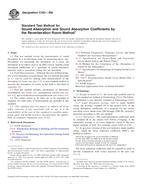
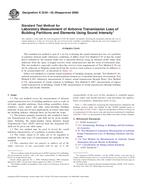 ASTM E2249-02(2008)..
ASTM E2249-02(2008)..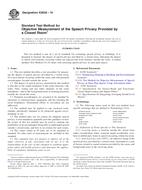 ASTM E2638-10
ASTM E2638-10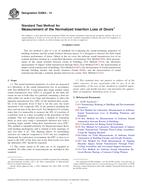 ASTM E2964-14
ASTM E2964-14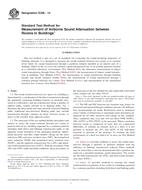 ASTM E336-14
ASTM E336-14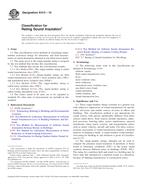 ASTM E413-10
ASTM E413-10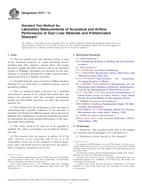 ASTM E477-13
ASTM E477-13
 Cookies
Cookies
